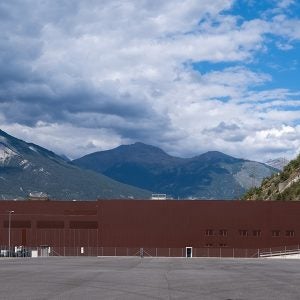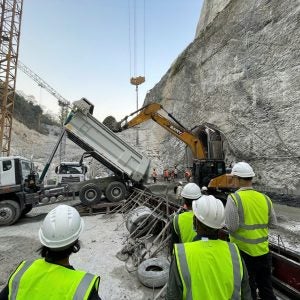The McNair Creek hydroelectric project is a 9MW run of river project located on British Columbia’s Sunshine Coast, about 30km northwest of Vancouver in the traditional territory of the Squamish First Nation. The project was completed in 2005 and is owned and operated by Renewable Power Corporation. It was constructed under an EPC contract that guaranteed price, schedule and performance with Peter Kiewit Sons Co as the prime contractor and Knight Piésold Ltd as the lead design engineer. This EPC team was successful in meeting or exceeding all the terms of the EPC contract, delivering the project on budget and ahead of schedule. Community consultation, strict environmental management plans and monitoring, project management, innovative design concepts, project optimization and great team work all played a key part in the projects success. These included:
• Web-based project management system
• Coanda (“shear-effect”) intake screens, which are self-cleaning and eliminate sediment inclusion into the penstock at the intake.
• Elimination of anchor block requirements along the pipeline and penstock.
• Optimization of installed capacity ensuring the best possible return on investment for the Owners.
• Construction of fisheries habitat enhancement and spawning channels downstream of the powerhouse tailrace. This was further developed into a park like setting for the local community with 22 Chum Salmon returning to spawn in these channels the first year after construction.
• A dry transformer (without oil) was used eliminating the possibility of an oil spill.
• This project has one of the most advanced monitoring systems of plant operations and environmental variables such as rainfall, temperatures and flows.
• Ongoing monitoring of fish stocks is providing for scientific evidence of low flow requirement to sustain fish and other aquatic populations.
• Improvements to hiking trails.
The basic characteristics of the project are summarized as follows:
• Owner & Operator – Renewable Power Corporation
• Prime Contractor – Peter Kiewit Sons Co.
• Lead Designer – Knight Piésold Consulting
• Nameplate Capacity – 9MW
• Average Annual Energy – 35GWh
• Gross Head – 338m
• Design Flow – 3.3m3/sec
• Diversion Weir & Intake – A reinforced concrete structure comprising a free overflow spillway incorporating a Coanda screen (Aqua-shear screen), a bypass sluiceway and penstock isolation gate
• Intake – Sluice channel, screens, trash rake, vortex desander and penstock isolation gate
• Tributary Intakes – Two tributary intakes with a maximum combined capacity of 0.6m3/sec divert water into the main intake headpond
• Powerhouse – Concrete substructure and pre-fabricated steel super structure, with removable roof panels to allow for extraction of the turbine generator set with the use of a mobile crane
• Turbine – One 5-Jet Vertical Axis Pelton unit
• Generator – Direct coupled synchronous generator, generating at 4.16kV
• Switchyard – 4.16kV to 25kV
• Transmission & Interconnection – 25kV
• Fisheries Enhancement Channel – 200m long with both rearing pond and spawning channel habitat
During the development phase there was extensive consultation with the local community, stakeholders and First Nations groups that helped to shape the final configuration of the project. This resulted in the inclusion of the fisheries enhancement channel and improved hiking trails, including a timber bridge over the powerhouse tailrace channel with minimum disturbance to the riparian vegetation along the banks of McNair Creek. There is joint use of the penstock with the Sunshine Coast Regional District, saving them the cost of building their own infrastructure for drinking water and fire hydrants. The project also resulted in Partial ownership and employment for First Nations and the penstock was buried for greater resident/wildlife access.
As with all projects developed in BC, the McNair Creek Project had to go through a rigorous environmental assessment and permitting phase in order to secure all the Provincial and Federal approvals and licences. A typical run-of-river project in BC will require more than 50 permits, licences, approvals and reviews from 14 regulatory bodies, including federal, provincial, local and First Nations. The project is now EcoLogo certified in Canada.
The innovative design concepts developed by Knight Piésold and Kiewit resulted in significant cost and schedule benefits. A Coanda screen intake design provides a low maintenance, self cleaning solution that eliminates the need for an expensive desanding basin, resulting in significant cost and schedule savings.
The project now provides clean renewable energy to BC Hydro under a long term contract, helping BC meets its goal of energy self sufficiency by 2016 with 90% of its electricity coming from renewable sources.
For further information contact:
Sam Mottram, Manager – Power Services, Knight Piésold, Vancouver. Email: smottram@knightpiesold.com
Peter Schober, Owner, Renewable Power Corp. www.renewablepowercorp.com

The buried penstock at McNair Creek

The buried penstock at McNair Creek

The Coanda screen intake and headpond

McNair Creek Powerhouse
Related Articles
Best of the best in small hydro
Canedo project wins IWP&DC award






